![]()
![]()
![]()
Use LEFT and RIGHT arrow keys to navigate between flashcards;
Use UP and DOWN arrow keys to flip the card;
H to show hint;
A reads text to speech;
17 Cards in this Set
- Front
- Back
|
Define cytokines
|
Proteins that mediate cellular interactions and regulate cell growth and secretion. As a result, they regulate many aspects of the immune system
|
|
|
Define chemokine
|
A family of proinflammatory and chemotactic cytokines with a characteristic sequence of 4 cysteine residues. They regulate the emigration of leukocytes from blood into tissues.
|
|
|
Define Interleukins
|
are cytokines that regulate the interactions between lymphocytes and other leukocytes (e.g. IL-1 to IL-30).
|
|
|
Define interferons
|
are antiviral cytokines that are produced in response to virus infection or immune stimulation (e.g. IFN-α, β, γ).
|
|
|
Define tumor necrosis factors
|
Macrophage and T cell derived cytokines that can exert a direct toxic effect on neoplastic cells. (e.g. TNF-α, β)
|
|
|
How many interleukins are there? What are the ones that we need to know? What are their actions?
|
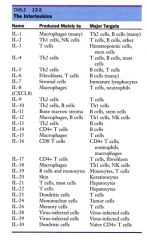
There are 30 interleukins.<br />The ones we should know: IL-1, 2, 4, 5, 6, 10 (produced by Th2, but inhibits Th1 – an immune suppressive cytokine), 12 (stimulate Th1)
|
|
|
What are the types and kinds of interferons that we need to know?
|
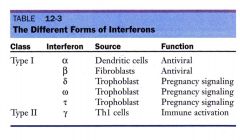
type I antiviral; II – immune activation
We need to know a and B of type I, then type II (gamma) |
|
|
Define pleiotropy
|
Most cytokines act on different target cell types inducing different responses in each one.
IL-1 plays a key role in inflammation, hematopoiesis, bone metabolism, and acquired immunity. Acts on different cells, induces different functions in each |
|
|
Define redundancy
|
Many different cytokines may act on a single target.
IL-3, IL-4, IL-5 & IL-6 all affect B cell function. |
|
|
Define synergy
|
Some cytokines work best in association with other cytokines.
Combination of IL-4 & IL-5 stimulates B cell switching to IgE production. |
|
|
Define antagonism
|
Some cytokines may antagonize the effects of other.
Mutual antagonism of IL-4 and IFN-γ. |
|
|
What are the mechanisms that control cytokine activity? Specifically IL-1 and TNFa.
|
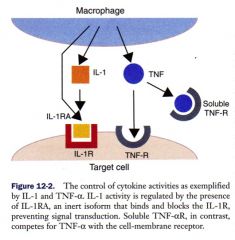
Many of the cytokines oppose each other, this is one way that they are kept in check. The macrophage also produces the IL-1 receptor antagonist, in addition to IL-1. When it takes up the spot of IL-1, it doesn’t cause a cascade, just prevents IL-1 from causing one. Many cells will produce the soluble TNF receptors to lead them astray from binding on the target cell (not just the macrophage produces them)
|
|
|
What cytokines do macrophages secrete?
|
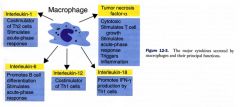
see pic
|
|
|
What are the cytokines that Th1 cells secrete
|
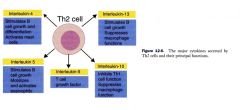
IL2 and INFy
|
|
|
What cytokines do Th2 cells secrete?
|
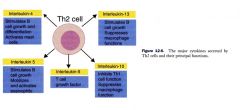
see pic
|
|
|
Define virokines. What are some virokines (especially the one that effects IL-10 and why that is important)?
|
some viruses produce proteins that are closely related to or may affect, mammalian cytokines. Virokines inhibit antiviral immune response.
Vaccinia and cowpox virus produce IL-1-binding protein that inhibits IL-1 Human herpesvirus, Epstein-Barr virus, makes a protein closely related to IL-10 (vIL-10) that reduces the T-cell response to the virus. IL-10 is inhibits Th1 Myxoma and pox viruses produce a protein related to IFN-γR that binds IFN-γ thus preventing its antiviral effects. |
|
|
What is TGF-B? What are its three fundamental activities?
|
These are important for animals in the womb. Helps in production of ECM and in immune response.
Produced by many cells and act on many targets including immune cells. Three fundamental activities 1. They regulate growth, differentiation, & function of all lymphocytes, Dendritic Cells, & MØ. 2. Immunosuppressive 3. Enhance the deposition of extracellular matrix proteins. |

